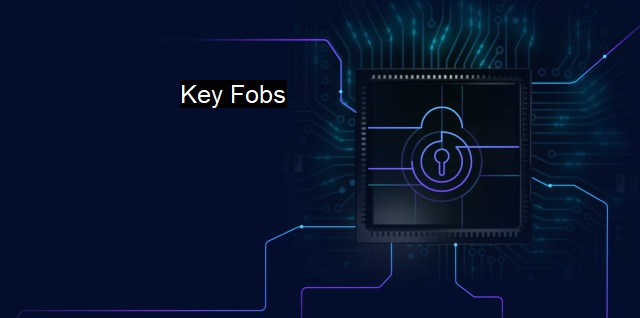What are Key Fobs?
Exploring the Key Fob: A Vital Access Control Device in Cybersecurity Enterprise Security
Key fobs are ubiquitous in today’s technology-laden environment. Refreshingly, in a world where intimidating jargon often obfuscates understanding, 'key fob' lends itself to a straightforward definition. Visually similar to traditional keys or small trinkets from a keychain, key fobs are small, convenient, and practical devices capable of facilitating secure access to physical or digital spaces. Understandably, they have significant connotations within the sphere of cybersecurity and antivirus practices and, as such, merit thorough examination.An intelligence-laden component of tech infrastructure, the primary purpose of a key fob is authentication. They are hardware tokens that provide access to, and help secure, networks and information and are based on a system of factors; predominantly, these are knowledge factors (information known only by the user), inherence factors (unique characteristics of the individual, e.g., a fingerprint), and possession factors (items physically possessed by the user).
Key fobs typically employ the possession factor, serving the function of proving allegiance between who a user claims they are and an authenticatable programmed identifier (such as a serial number). This verification is tamper-proof and discourages unauthorized cyber attackers from obtaining privileged access.
There are two primary types of key fobs. The first provides a continually changing, random number, generated by an algorithm. When the user attempts to access the linked network or information, they must input this number as further proof of their identity. The second type uses a method called 'public key cryptography' which entails a constructed pair of long numbers recognized as 'keys,' one private, the other public. The private key is stored securely within the key fob, the public key is open information. Thus, a issued unique identifier creates a connection with the accessed network or system.
In the context of the ever-evolving realm of cybersecurity, key fobs serve an essential role. In using a possession factor physically secured by the user in question, they create an additional line of defense uncompromised by foul play, such as the divulgence of personal details or the habitually sloppy practice of weak password generation and retention. since the details stored within a key fob's hardware are often encrypted, they are extremely resistant to hacking and offer a much higher degree of security compared to customary passwords.
Key fobs can be vulnerable themselves if not handled correctly. The security field terms this a 'man-in-the-middle-attack'. Here, direct communication between two users is clandestinely infiltrated and manipulated. Paradoxically, despite working to increase security, the device can unanimously grant a malicious third party simultaneous access. This necessitates continuous updates and evolution in its technology to contain these threats effectively.
Antivirus programs, also called antimalware, follow a similar ideology. Recalling the digital arms race posited by the existence of malware and attempts to control the escalating threats stemming from it, at their core, antivirus programs also function on the tenets of recognition and eradication. the critical difference lies in operating procedure: while the antivirus software operates over a vast network, scanning files and systems for recognized threats, key fobs work to secure individual access points, for unique users, to specialized networks or information facilities.
Simultaneously, they operate symbiotically. Secure access nonsense checks by the key fobs render potential lurking vulnerabilities of an antivirus system void. On the other hand, cybersecurity threshold surveillance by antivirus software ensures external threats are minimal, thereby fortifying the individual end-user protection provided by key fobs.
In the modern climate of escalating cybersecurity threats, key fobs offer an invaluable tool in safeguarding information and ensuring secure user access to networks. In tandem with antivirus software, they can further strengthen cybersecurity measures, thereby greatly reducing, if not entirely abolishing, existing vulnerabilities. Technological vigilance and skill will be decisive for future enhancements of these important security mechanisms. The stakes are high, but the technology being brought to bear on the challenge is impressive and only becoming more robust.

Key Fobs FAQs
What is a key fob in the context of cybersecurity?
In the context of cybersecurity, a key fob is a small electronic device that provides access to a secure network or system. It often works in conjunction with a password or other authentication mechanisms to enhance security.Can key fobs improve cybersecurity?
Yes, key fobs can improve cybersecurity as they provide an additional layer of authentication and can make it harder for unauthorized individuals to access sensitive information. In particular, key fobs that use two-factor or multi-factor authentication can be highly effective at preventing cyber attacks.How do key fobs work?
Key fobs typically work by sending a unique code to a server or access point when activated. This code is verified against the user's credentials and access is granted if the information matches. Some key fobs may also use biometric data or other forms of authentication to further enhance security.Are all key fobs secure?
While key fobs can be highly secure, not all devices are created equal. Some key fobs may use outdated encryption protocols or have vulnerabilities that can be exploited by hackers. To ensure the highest level of security, it's important to choose a key fob from a reputable manufacturer and keep it up-to-date with the latest firmware updates.| | A | | | B | | | C | | | D | | | E | | | F | | | G | | | H | | | I | | | J | | | K | | | L | | | M | |
| | N | | | O | | | P | | | Q | | | R | | | S | | | T | | | U | | | V | | | W | | | X | | | Y | | | Z | |
| | 1 | | | 2 | | | 3 | | | 4 | | | 7 | | | 8 | | |||||||